In knit weaving, the knit carriage is threaded with the main yarn as usual. The choice of pattern is determined by needle selection. The most basic technique involves pulling the desired weaving needles forward manually or by using needle pushers which are available in a range of selection options. Automatic needle selection makes the process faster, consistent, and capable of more variations.
The weaving yarn, according to instructions in manuals, may be threaded through the tension mast and guided through the weaving yarn guide. Feeding thicker yarn smoothly through the standard mast may become problematic. Moving yarn from the groove on one side to that on the other is cumbersome. The punchcard machine manual for the 860 machines has some clear illustrations and directions 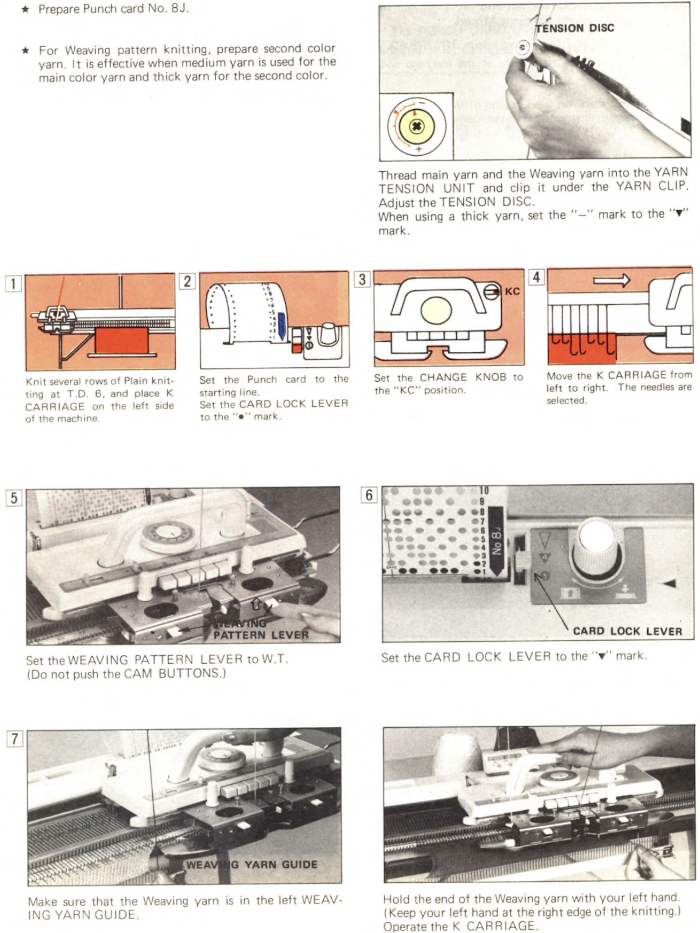
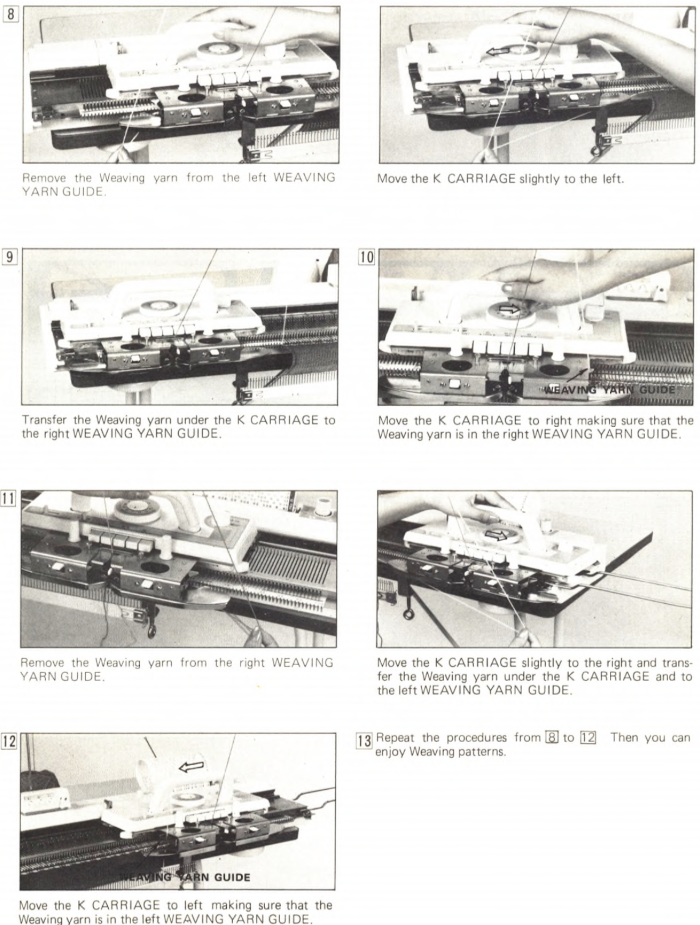 From the 260 manual:
From the 260 manual:  The “yarn guide” is that mysterious notch in each arm of the sinker plate. In the Studio accessory, the AW1 weaving arm, the yarn is also fed through the yarn mast, and moved physically from side to side after each pass of the carriage.
The “yarn guide” is that mysterious notch in each arm of the sinker plate. In the Studio accessory, the AW1 weaving arm, the yarn is also fed through the yarn mast, and moved physically from side to side after each pass of the carriage. 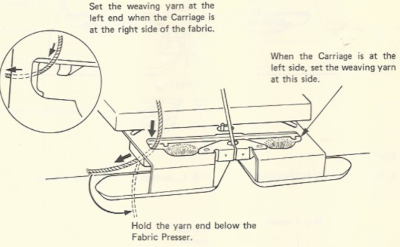 Start the piece with waste yarn and some evenly distributed weight based on fabric width. Make sure the weaving brushes are activated. In Brother standard, their position is changed using the corresponding lever, in the bulky 260 the L and R wheel brushes need to be placed in their corresponding slots.
Start the piece with waste yarn and some evenly distributed weight based on fabric width. Make sure the weaving brushes are activated. In Brother standard, their position is changed using the corresponding lever, in the bulky 260 the L and R wheel brushes need to be placed in their corresponding slots.  A good repeat, to begin with, is one that selects every other needle, every other row. The card is a standard factory issue with punchcard machines.
A good repeat, to begin with, is one that selects every other needle, every other row. The card is a standard factory issue with punchcard machines.  In general, the knitting yarn is thinner than the weaving one. The tension needs to be adjusted to accommodate the surface yarn, not the background one. The tighter the tension the firmer and narrower the weave. It is also possible to create soft knits with a lot of drape ie by using sewing thread for the ground and fine mohair for the weft, there is a huge range for exploration.
In general, the knitting yarn is thinner than the weaving one. The tension needs to be adjusted to accommodate the surface yarn, not the background one. The tighter the tension the firmer and narrower the weave. It is also possible to create soft knits with a lot of drape ie by using sewing thread for the ground and fine mohair for the weft, there is a huge range for exploration.
The “weft” precedes the base knitting yarn which knits the stitch. It is laid over the top loop of the old stitch on a needle selected by a hole in the card and goes underneath the top loop of a previous stitch on a needle not selected by a blank on the card. When card 1, above, is in use, the weaving yarn is caught in a series of two loops, one above, and one below forming a honeycomb effect. The structure is typically illustrated in these ways in Japanese reference books and magazines in particular. 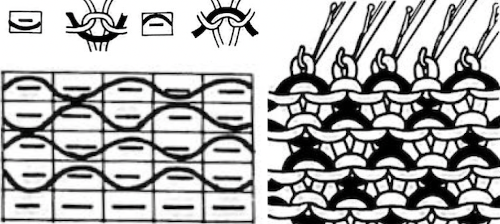
 Early Brother punchcard volumes have illustrations of the over_under structures and in-between floats along with providing the pattern repeats.
Early Brother punchcard volumes have illustrations of the over_under structures and in-between floats along with providing the pattern repeats. 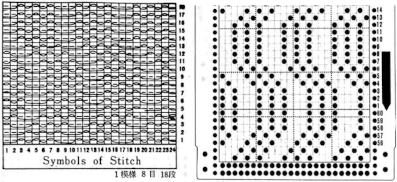 Setting things up: the weaving yarn is in front of the machine, fed from the floor. The short end goes to the carriage side, the long end is away from it. It is laid in front of the gatepegs, atop selected needles. A clothespin can provide enough weight on the short end to keep it from riding up and having to be managed with one’s hand. “Weaving” can begin from either side, here it starts on the left. Knitting in 2-row sequences will return the yarn ends to the starting position.
Setting things up: the weaving yarn is in front of the machine, fed from the floor. The short end goes to the carriage side, the long end is away from it. It is laid in front of the gatepegs, atop selected needles. A clothespin can provide enough weight on the short end to keep it from riding up and having to be managed with one’s hand. “Weaving” can begin from either side, here it starts on the left. Knitting in 2-row sequences will return the yarn ends to the starting position. 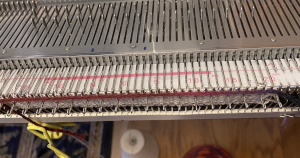 Locking the card, as with any other pattern, will repeat the same needle selection, creating vertical repeats that resemble twill weaving on a loom.
Locking the card, as with any other pattern, will repeat the same needle selection, creating vertical repeats that resemble twill weaving on a loom.
a: card set to advance normally, b: card locked 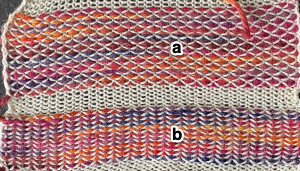 a: because stitches are actually knitting every other row, slipping while the needles on each side of them knit, they will alternately be a bit elongated; b: same needles knit every row, so their appearance is consistent.
a: because stitches are actually knitting every other row, slipping while the needles on each side of them knit, they will alternately be a bit elongated; b: same needles knit every row, so their appearance is consistent. 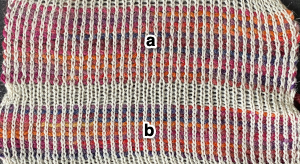 Depending on the difference in yarn thickness, the knit stitches in the ground become forced apart with what can be significant “bleed-through” on the reverse of the weaving to make that a really interesting fabric feature as well.
Depending on the difference in yarn thickness, the knit stitches in the ground become forced apart with what can be significant “bleed-through” on the reverse of the weaving to make that a really interesting fabric feature as well.
Some weaving patterns with variable floats will produce better edges if the end needles are brought out to E in every row if not selected to that position by the reader.
If a hairy or fuzzy yarn such as mohair is used the fabric may start to bunch up, it may be necessary to reach up from behind the knitting and gently pull to release the little hairs from the gate pegs.
Most punchcards designed for weaving aim for short floats formed by unpunched areas, longer ones on occasion are planned for added manipulation.
Moving the yarn from the groove on one side to that on the other is cumbersome. Another way of working: the main yarn is threaded as usual and the weaving yarn sits on the floor. The method is often referred to as intarsia weaving. The shapes may be created using various punchcard designs ie diamonds, squares, etc, free-forming, or even through following planned drawings on knitleader mylar garment shapes.
The knitter guides the yarn. If the yarn is held too loosely it may jump off the knitting while weaving and thus create long loops. It should be guided and held just enough to slip through the hand as the carriage is passed.
Preselect for the first row of knitting. Lay the weaving yarn across selected needles in the direction in which the carriage will be moving.
If using yarns of different yarn weights within the piece, multiple strands of the thinner yarn may be used together, but test how the strands feed and if plying might lead to problems. Using wrapping methods on some rows or even creating floats and hooking them up periodically can produce added interest.
If using more than one yarn per row, the approach is similar to intarsia. In true intarsia, every needle is in use. These illustrations are from an intarsia carriage manual; positioning the yarns for a first row from right to left, 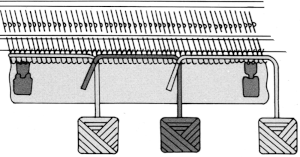 the “wraps” needed in each direction
the “wraps” needed in each direction ![]() In knit weaving, assuming the first pattern row is preselected from left to right, with COR, the short end of the yarn of the carriage side, bring the first weaving yarn up from the floor, and lay it to the left across the selected needles, bringing it down between the last selected needle for A, and the first selected needle for B.
In knit weaving, assuming the first pattern row is preselected from left to right, with COR, the short end of the yarn of the carriage side, bring the first weaving yarn up from the floor, and lay it to the left across the selected needles, bringing it down between the last selected needle for A, and the first selected needle for B.  In one method, bring the long end of the second yarn, B, up on the right side of the needle over which A just crossed, and lay it over the remaining selected needles and down to the floor.
In one method, bring the long end of the second yarn, B, up on the right side of the needle over which A just crossed, and lay it over the remaining selected needles and down to the floor. Small clothespins may be used to hold the short ends in place. When all the yarns have been laid in, grasp the ends loosely, pass the carriage to the left, and the first woven row will have been completed. The carriage will now be on the left, COL. For the next row begin on the right, bring A up and between the two needles directly above it, take it over selected needles to the end of selected needles, and down to the floor. Then take yarn B and bring it up around the left-hand needle, over and to between the two needles that served as the starting position for A. The yarns do not overlap the same needle going to the right, but they do to the left.
Small clothespins may be used to hold the short ends in place. When all the yarns have been laid in, grasp the ends loosely, pass the carriage to the left, and the first woven row will have been completed. The carriage will now be on the left, COL. For the next row begin on the right, bring A up and between the two needles directly above it, take it over selected needles to the end of selected needles, and down to the floor. Then take yarn B and bring it up around the left-hand needle, over and to between the two needles that served as the starting position for A. The yarns do not overlap the same needle going to the right, but they do to the left.
The more traditional intarsia crossings may also be used, with the new yarn passing under and over the old between needles, as seen here with the next row to be knit from left to right. 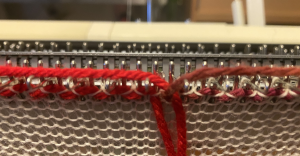 a: crossings made using the traditional intarsia method, b: wrapping over the adjacent needle moving from left to right, c: no crossing at all also revealing single knit stitches between weaving yarns. In some spots, my weaving yarn split and got knit along with the ground yarn.
a: crossings made using the traditional intarsia method, b: wrapping over the adjacent needle moving from left to right, c: no crossing at all also revealing single knit stitches between weaving yarns. In some spots, my weaving yarn split and got knit along with the ground yarn. 
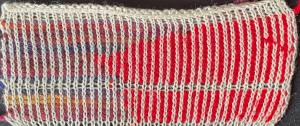 To create isolated shapes: lay the yarn in any chosen area
To create isolated shapes: lay the yarn in any chosen area  Shaping may happen in a straight vertical, a, there may be a slight separation along that edge. Increases are possible on both sides at the same time, and are best done by adding single new selected needles to the pattern, b. Moving further out crossing over more weaving needles will cause floats, as seen in c and d. The woven segment forces the knit stitches apart, so the stocking stitch on either side of the shapes, e, appears to be formed by smaller stitches, and pulls in toward the shape
Shaping may happen in a straight vertical, a, there may be a slight separation along that edge. Increases are possible on both sides at the same time, and are best done by adding single new selected needles to the pattern, b. Moving further out crossing over more weaving needles will cause floats, as seen in c and d. The woven segment forces the knit stitches apart, so the stocking stitch on either side of the shapes, e, appears to be formed by smaller stitches, and pulls in toward the shape

 The ground yarn and color may be changed for added striping and color interest. Sharp angles are created by crossing over two weaving needles, and more gradual ones by crossing over more needles. Blank areas of ground may be left as well.
The ground yarn and color may be changed for added striping and color interest. Sharp angles are created by crossing over two weaving needles, and more gradual ones by crossing over more needles. Blank areas of ground may be left as well.
The intarsia approach may also be used with other cards designed for all-over patterning.
Using far thicker yarns may be made manageable when changing the card repeat or using weaving repeats with 12-stitch wide repeats, working on specific needles on a punchcard machine, or simply programmed twice as wide on electronic ones. The expanded version of every other needle set up for the punchcard models.  Sometimes plain knit rows need to be added between lines of weaving to help manage thicker yarns in any configuration or to add color interest and width changes to the piece.
Sometimes plain knit rows need to be added between lines of weaving to help manage thicker yarns in any configuration or to add color interest and width changes to the piece.
Woven rows may be used to create folds in pleats.
Other weaving techniques include the pulling-up method, as a stand-alone or combined with lace patterning: from a Brother punchcard volume  Three more hooking-up variations, including latching graduated-size floats
Three more hooking-up variations, including latching graduated-size floats 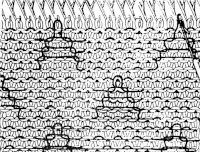
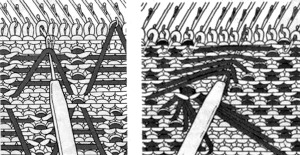
 A later experiment combining weaving with tuck patterning
A later experiment combining weaving with tuck patterning  Hand techniques: e-wrap rows may also be incorporated with any of the above or used alone, sketches of some varieties may be used around every needle or every other depending on the thickness of the yarn: a sketch eons ago
Hand techniques: e-wrap rows may also be incorporated with any of the above or used alone, sketches of some varieties may be used around every needle or every other depending on the thickness of the yarn: a sketch eons ago  Commercial warp knit structures are often represented as in this illustration.
Commercial warp knit structures are often represented as in this illustration. 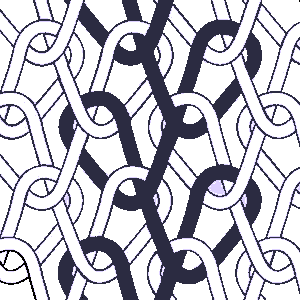 On domestic knitting machine models, a knit ground is needed to anchor the moving loops, which in turn are added on as a hand technique, referred to as vertical weaving, sometimes simply as embroidery.
On domestic knitting machine models, a knit ground is needed to anchor the moving loops, which in turn are added on as a hand technique, referred to as vertical weaving, sometimes simply as embroidery.
Japanese instructions that came with the purchase of the standard garter bar had schematics for a variety of surface treatments. The accessory came with foam-backed strips intended to be clipped onto the width of the garter bar segment being used, useful in maintaining even spacing between yarn threads when working on wide areas of vertical weaving, as well as providing helpful weight. Any weight used to help handle the long ends of the weaving yarn on any number of threads will need to be moved down periodically. 
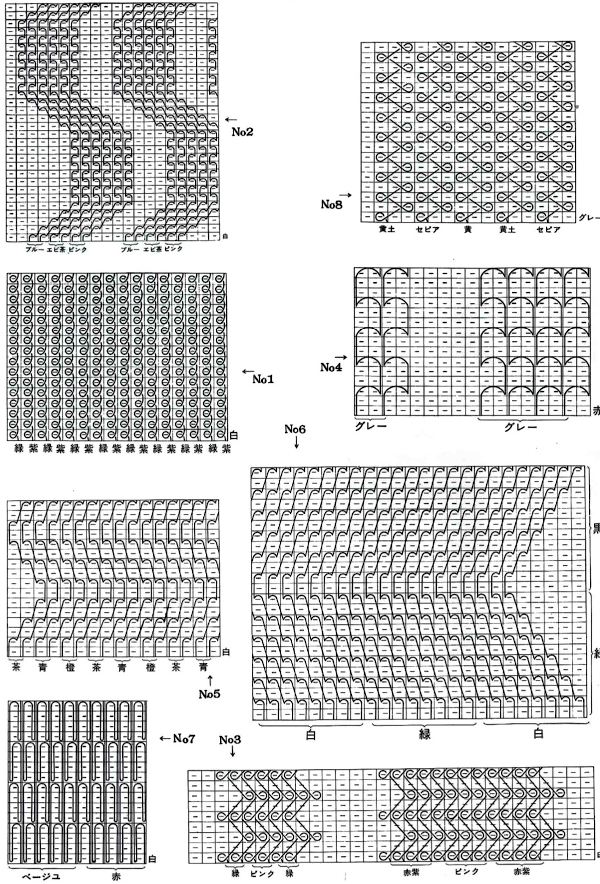 More wrap ideas
More wrap ideas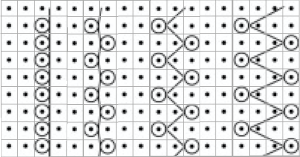
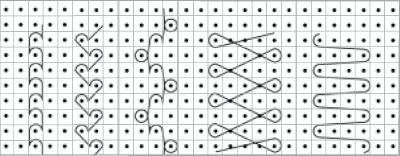 Variations can happen by changing the spacing between wrapped stitches, the number of rows between the moves, spacing threads apart, and using yarns in different thicknesses and colors.
Variations can happen by changing the spacing between wrapped stitches, the number of rows between the moves, spacing threads apart, and using yarns in different thicknesses and colors.
In terms of tools to hold the weaving yarns, in addition to the garter bar, multiple transfer tools may be used, even bobbins. That said, the most efficient way is to have a guide suitable for the overall fabric, especially when creating wider pieces with spaced weaving repeats. It is possible to create cardboard guides with holes based on gauge, whether on the standard or the bulky and with 3D printing nowadays a whole other world for custom tools is open. Matching the gauge with guides has some leeway, but the closer the match, the faster and easier the process. When using thicker yarns for the warp knit, spacing in both stitches and rows becomes a necessity.
A half-hearted attempt at a template. Markings were generated to be point/mm specific. If working in narrow panels, individual segments may be more effective to manage if a bit slower to use than a wider tool.
 This is the wrong way to feed the yarn, as the row gets knit woven in, the yarn will be locked in place and cannot be advanced to proceed up the knit
This is the wrong way to feed the yarn, as the row gets knit woven in, the yarn will be locked in place and cannot be advanced to proceed up the knit  The way to have continuously available yarn
The way to have continuously available yarn 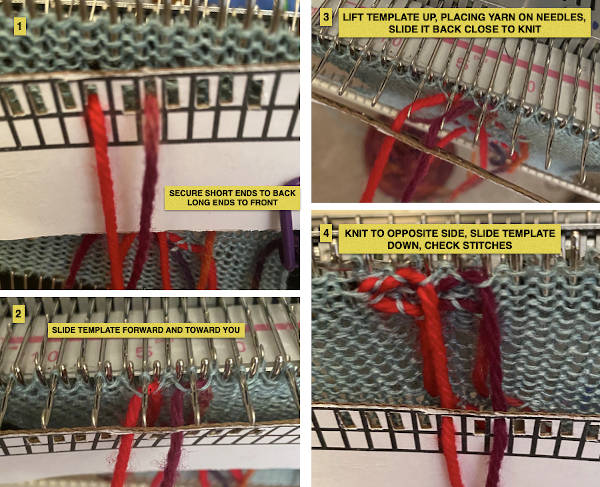 Adding a second set of holes for the yarn stabilize the short yarn ends and maintain even spacing throughout, some tape could be used in addition to secure the ends on wider widths of vertical weave
Adding a second set of holes for the yarn stabilize the short yarn ends and maintain even spacing throughout, some tape could be used in addition to secure the ends on wider widths of vertical weave  A spreadsheet or graph paper may be used to plan the configuration of the weaves including double wraps, this was executed using Numbers, individual bobbins might be a practical consideration
A spreadsheet or graph paper may be used to plan the configuration of the weaves including double wraps, this was executed using Numbers, individual bobbins might be a practical consideration  In my own experience most hand techniques and single bed textures are far easier to execute with the ribber removed. It is easier to view progress, move up weights, and correct mistakes. That said, my machines are all set up with the ribber brackets, not flat, I feel it helps slide the knit down toward the gate pegs, and in my opinion that makes textures and even lace easier to produce. I have ribber covers, they can be improvised if needed with paper or cloth, never use them since I see no reason for moving the knit on the top bed in front of the ribber. If the ribber is removed, it is worth checking its balance once more prior to returning to any rib knit. Ultimately this sort of thing is about personal preference, no steps are ever universally applicable and correct.
In my own experience most hand techniques and single bed textures are far easier to execute with the ribber removed. It is easier to view progress, move up weights, and correct mistakes. That said, my machines are all set up with the ribber brackets, not flat, I feel it helps slide the knit down toward the gate pegs, and in my opinion that makes textures and even lace easier to produce. I have ribber covers, they can be improvised if needed with paper or cloth, never use them since I see no reason for moving the knit on the top bed in front of the ribber. If the ribber is removed, it is worth checking its balance once more prior to returning to any rib knit. Ultimately this sort of thing is about personal preference, no steps are ever universally applicable and correct.
Tufting may be created with the help of a sewing machine.
“Weaving” foreign objects can be achieved by picking up loops from other knits, woven, trims, crochet chains, etc. Beads may be threaded onto weaving yarn as well.